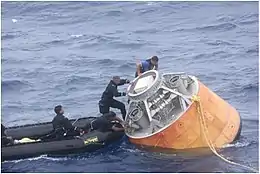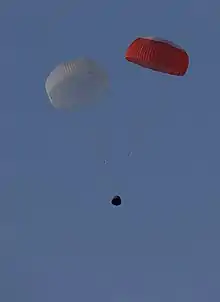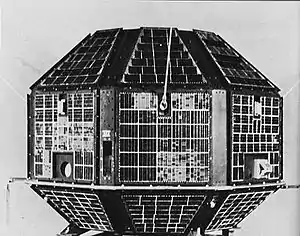Gaganyaan
Gaganyaan (Sanskrit; IAST: gagan-yāna) transl. "Sky Craft") is an Indian crewed orbital spacecraft intended to be the formative spacecraft of the Indian Human Spaceflight Programme. The spacecraft is being designed to carry three people, and a planned upgraded version will be equipped with rendezvous and docking capability. In its maiden crewed mission, Indian Space Research Organisation (ISRO)'s largely autonomous 3.7-tonne (8,200 lb) capsule will orbit the Earth at 400 km (250 mi) altitude for up to seven days with a two or three-person crew on board. The crewed vehicle was originally planned to be launched on ISRO's GSLV Mk III in December 2021,[11][12] but this has since been delayed to no earlier than 2022.[6] This Hindustan Aeronautics Limited (HAL) manufactured crew module had its first un-crewed experimental flight on 18 December 2014.[13] As of May 2019, design of the crew module has been completed.[14] Defence Research and Development Organisation (DRDO) will provide support for critical human-centric systems and technologies like space grade food, crew healthcare, radiation measurement and protection, parachutes for the safe recovery of the crew module and fire suppression system.[15]
| Manufacturer | Defence Research and Development Organisation Hindustan Aeronautics Limited Indian Space Research Organisation |
|---|---|
| Country of origin | India |
| Operator | ISRO |
| Applications | Crewed orbital vehicle |
| Specifications | |
| Spacecraft type | Crewed |
| Design life | 7 days |
| Launch mass | 8,200 kg (18,100 lb) (includes service module) [1] |
| Dry mass | 3,735 kg (8,234 lb)[2] |
| Crew capacity | 3 [3] |
| Dimensions | Diameter: 3.5 m (11 ft)[4] Height: 3.58 m (11.7 ft) [4] |
| Volume | 8 m3 (280 cu ft)[5] |
| Power | Photovoltaic array |
| Regime | Low Earth orbit |
| Production | |
| Status | In development |
| Maiden launch | Q4 2021 (uncrewed)[6][7][8] 2022 (Second uncrewed) 2022 (crewed)[6][9][10] |
On 11 June 2020, it was announced that while the first uncrewed Gaganyaan launch has been delayed due to COVID-19 pandemic in India,[16] overall timeline for crewed launches is expected to remain unaffected.[17]
History
Preliminary studies and technological development of Gaganyaan started in 2006 under the generic name "Orbital Vehicle". The plan was to design a simple capsule with an endurance of about a week in space, a capacity of two astronauts, and a splashdown landing after re-entry. The design was finalized by March 2008 and was submitted to the Government of India for funding. The funding for the Indian Human Spaceflight Programme was sanctioned in February 2009,[18] but it fell short of full political support and obtained limited developmental funding.[18] Initially, the first uncrewed flight of the orbital vehicle was proposed to be in 2013,[19][20] then it was revised to 2016.[21] However, in April 2012 it was reported that funding problems placed the future of the project in serious doubt;[22] and in August 2013 it was announced that all crewed spaceflight efforts by India had been designated as being 'off ISRO's priority list'.[23] By early 2014 the project was reconsidered and was one of the main beneficiaries of a substantial budget increase announced in February 2014.[24] ISRO is developing the Gaganyaan orbital vehicle on the tests performed with their scaled 550 kg Space Capsule Recovery Experiment (SRE), which was launched and recovered in January 2007.[25][26]
The latest push for the Indian Human Spaceflight Programme took place in 2017,[27] and it was accepted and formally announced by the Prime Minister Narendra Modi on 15 August 2018.[28] The current design calls for a crew of three.[3] ISRO will perform four biological and two physical science experiments related to micro-gravity during the Gaganyaan mission.[29]
Funding and infrastructure
A crewed spacecraft would require about ₹ 124 billion (US$1.77 billion) over a period of seven years, including the ₹ 50 billion (US$0.7 billion) for the initial work of the crewed spacecraft during the Eleventh Five-Year Plan (2007–12) out of which the Government released ₹ 500 million (US$7 million) in 2007-08.[30][31] In December 2018, the government approved further ₹ 100 billion (US$1.5 billion) for a 7-days crewed flight of 3 astronauts to take place by 2021.[11]
Madhavan Chandradathan, director of Satish Dhawan Space Centre (SDSC), stated that ISRO would need to set up an astronaut training facility in Bangalore. Newly established Human Space Flight Centre (HSFC) will coordinate the IHSF efforts.[32] Existing launch facilities will be upgraded for launches under Indian Human Spaceflight project[33][34] with extra facilities needed for launch escape systems.[31] Russia is likely to provide astronaut training, and assist with some aspects in the development of the launcher.[35] In spring 2009 the full-scale mock-up of crew capsule of Gaganyaan was built and delivered to Satish Dhawan Space Centre for training of astronauts.[36]
India has already successfully developed and tested several building blocks, including re-entry space capsule, pad abort test, safe crew ejection mechanism in case of rocket failure, flight suit developed by DEBEL and the powerful GSLV-MkIII launch vehicle.[37] Having met all required technological keystones, the Indian Human Spaceflight Programme was accepted and formally announced by the Prime Minister Narendra Modi on 15 August 2018. Gaganyaan will be the first crewed spacecraft under this programme.
ISRO's Human Space Flight Centre and Glavcosmos, which is a subsidiary of the Russian state corporation Roscosmos, signed an agreement on July 1, 2019 for cooperation in the selection, support, medical examination and space training of Indian astronauts.[38] An ISRO Technical Liaison Unit (ITLU) will be set up in Moscow to facilitate the development of some key technologies and establishment of special facilities which are essential to support life in space.[39]
On 25 October 2019, ISRO's Human Space Flight Centre and Glavcosmos signed a contract to evaluate the possibility of using Russian life support systems and thermal control for Gaganyaan.[40]
Description
Gaganyaan crew module is a fully autonomous 5.3-tonne (12,000 lb) spacecraft designed to carry a 3-member crew to orbit and safely return to the Earth after a mission duration of up to seven days. [1] Its 2.9-tonne (6,400 lb)[1] service module is powered by liquid propellant engines. The crew module is mated to the service module, and together they constitute 8.2-tonne (18,000 lb) orbital module.[1] The space capsule will have life support and environmental control systems. It will be equipped with emergency mission abort and emergency escape that can be done at the first stage or second stage of the rocket burn.[41] The nose of the original version of the orbital vehicle was free for a docking mechanism, but primary entry was evidently through a side hatch secured by explosive bolts.[42]
Following two non-crewed orbital flight demonstrations of the spacecraft, a crewed Gaganyaan is slated to be launched on the GSLV Mk III launcher no earlier than 2022.[6][11][12] Though the spacecraft is designed to carry 3 people, it is likely that the first flight will carry one person only. [43]
About 16 minutes after liftoff from the Satish Dhawan Space Centre (SDSC), Sriharikota, the rocket will inject the spacecraft into an orbit 300–400 km (190–250 mi) above Earth. When ready to land, its service module and solar panels will be disposed off before reentry. The capsule would return for a parachute splashdown in the Bay of Bengal.[44] Crew module is equipped with two parachutes for redundancy, while one parachute is good enough for safe splashdown. The parachutes would reduce the speed of the crew module from over 216 m/s (710 ft/s) to under 11 m/s (36 ft/s) at splashdown.[45]
List of flights
| Flight | Date | Regime | Crew | Notes | Outcome |
|---|---|---|---|---|---|
| Re-entry Test | 18 December 2014 | Sub-orbital | N/A | Sub-orbital test of scaled down Boilerplate Gaganyaan capsule, launched aboard the sub-orbital first test flight of ISRO's GSLV Mark III rocket. | Success |
| Pad Abort Test | 5 July 2018 | Atmospheric | N/A | 4-minute test of Gaganyaan's Launch abort system from launch pad at Satish Dhawan Space Centre. | Success |
| Gaganyaan 1 | Q4 2021 | LEO | N/A | First orbital test flight of Gaganyaan capsule. | Planned |
| Gaganyaan 2 | 2022 | LEO | N/A | Second orbital test flight of Gaganyaan capsule. | Planned |
| Gaganyaan 3 | 2022 | LEO | First crewed flight of Gaganyaan, will carry 1-3 Indian astronauts on a short orbital test flight. | Planned |
Testing


On 13 February 2014, Hindustan Aeronautics Limited handed over the first boilerplate prototype of Crew Module structural assembly to ISRO for Crew Module Atmospheric Re-entry Experiment (CARE).[13][50] ISRO's Vikram Sarabhai Space Centre would equip the Crew Module with systems necessary for life support, navigation, guidance and control systems. ISRO undertook an uncrewed test launch of the vehicle aboard the GSLV Mk3 X1, for an experimental sub-orbital flight on 18 December 2014. The GSLV Mk3 launcher with a dummy upper cryogenic stage (filled with liquid nitrogen to simulate weight of fuel) was launched at 9:30 am from the second launch pad at Satish Dhawan Space Center in Sriharikota.[51][52] The crew module separated from the rocket at an altitude of 126 km. On board motors controlled and reduced the speed of the module until an altitude of 80 km (50 mi). Thrusters were shutoff at that altitude and atmospheric drag further reduced speed of the capsule. The module heat shield was expected to experience temperature in excess of 1,600 °C (2,910 °F). Parachutes were deployed at an altitude of 15 km (9.3 mi) to slow down the module which performed a splashdown in the Bay of Bengal near Andaman and Nicobar islands.[53][54]
This flight was used to test orbital injection, separation and re-entry procedures and systems of the Crew Capsule. Also tested were the capsule separation, heat shields and aerobraking systems, deployment of parachute, retro-firing, splashdown, flotation systems and procedures to recover the Crew Capsule from the Bay of Bengal.[55][56] Inflight launch abort and parachute tests are expected to be conducted by the end of 2019.[57]
Pad abort test
The Indian Space Research Organisation's Pad Abort Test was conducted successfully on 5 July 2018.[58]
Vyommitra
On 22 January 2020 ISRO announced Vyommitra, a female-looking robot who will accompany the other astronauts in the mission. It can detect and give out warnings if environmental changes within the cabin get uncomfortable to astronauts and change the air condition, it can also take up postures suited for launch and tasks and take commands.[59]
See also
References
- Expert Talk by Dr R.Venkatraman, Dy.Director on Challenges in launch pad systems for Gaganyaan (Video). SDSC SHAR. 6 October 2020. Retrieved 6 October 2020.
- Indian Manned Spacecraft. Astronautix. 2014.
- Gaganyaan: Astronauts assigned to the mission are likely to be pilots, crew module design to be finalised soon. India Today. 20 January 2019.
- Kunhikrishnan, P. "India's Human Spaceflight Programme: GAGANYAAN" (PDF). UNOOSA. Archived from the original (PDF) on 20 February 2019. Retrieved 20 February 2019.
- "Integrated Cabin Pressure Control System" (PDF). isro.gov.in. ISRO. p. 11. Archived from the original (PDF) on 21 August 2019. Retrieved 23 August 2019.
- Kumar, Chethan (19 November 2020). "First crewless Gaganyaan flight only by end of 2021". The Times of India. Retrieved 20 November 2020.
- "First Unmanned Mission Under Gaganyaan By December 2020, Says ISRO Chief".
- "Tests for unmanned mission by 2020-end, says ISRO chief". The Hindu. 28 December 2019. Retrieved 30 December 2019.
- Rs 10,000 crore plan to send 3 Indians to space by 2022. The Times of India. 29 December 2018.
- "First Manned Mission" (Press release). Delhi: Department of Space. Press Information Bureau. 4 December 2019. Retrieved 6 December 2019.
- "Rs 10,000 crore plan to send 3 Indians to space by 2022 - Times of India". The Times of India. Retrieved 29 December 2018.
- Gaganyaan mission to take Indian astronaut to space by 2022: PM Modi. The Hindu. 15 August 2018.
- "Archived copy". Archived from the original on 22 February 2014. Retrieved 17 February 2014.CS1 maint: archived copy as title (link)
- "India's first solar mission in 2020: ISRO chairman". The Times of India. 4 May 2019. Retrieved 5 May 2019.
- "Gaganyaan: DRDO to provide special space food and emergency survival kit for ISRO's manned mission". The Financial Express. 4 March 2020. Retrieved 6 March 2020.
- "No Gaganyaan unmanned flight this year". The Weather Channel. 11 June 2020. Retrieved 13 June 2020.
- "India's first human space mission "Gaganyaan" will not be affected by COVID pandemic: Dr.Jitendra Singh". web.archive.org. 3 July 2020. Archived from the original on 3 July 2020. Retrieved 3 July 2020.
- Priyadarshi, Siddhanta (23 February 2009). "Planning Commission Okays ISRO Manned Space Flight Program". Indian Express. p. 2.
- "All India 10th, 12th Board, University, Entrance Exam Results 2018". www.examresults.net.
- "Gaganyan: How to send an Indian into space". 16 August 2018.
- Beary, Habib (27 January 2010). "India announces first manned space mission". Bangalore: BBC News. Retrieved 5 May 2010.
- Press Trust of India (25 April 2012). "Spaceflight stuck due to budget: CAG". Times of India. New Delhi. Retrieved 11 June 2013.
- Press Trust of India. "Human space flight mission off ISRO priority list". Retrieved 18 August 2013.
- "Rs 171 crore boost to manned space project - Times of India". The Times of India.
- China View: India's first space capsule returns to earth Archived 2008-05-02 at the Wayback Machine January 22, 2007
- ISRO Press Release Archived 2008-05-14 at the Wayback Machine January 22, 2007
- THE DECISION FOR INDIAN HUMAN SPACEFLIGHT PROGRAMME. POLITICAL PERSPECTIVES, NATIONAL RELEVANCE AND TECHNOLOGICAL CHALLENGES. (PDF) Mukund Kadursrinivas Raoa, Sridhara Murthi K. Rb, and Prasad M. 68th International Astronautical Congress (IAC), Adelaide, Australia, 25–29 September 2017.
- Indian will take national flag to space on board Gaganyaan by 2022, says PM Narendra Modi in Independence Day speech. Hindustan Times. 15 August 2018.
- "Lok Sabha, Unstarred Question number 2259" (PDF). 4 March 2020. Archived (PDF) from the original on 5 March 2020. Retrieved 4 March 2020.
- "Eleventh Five year Plan (2007-12) proposals for Indian space program" (PDF).
- Mishra, Bibhu Ranjan (8 October 2008). "ISRO plans manned mission to moon in 2014". Business Standard. Sriharikota Range (SHAR). Retrieved 14 June 2013.
- Ds, Madhumathi (11 January 2019). "ISRO starts Human Space Flight centre". The Hindu. ISSN 0971-751X. Retrieved 11 January 2019.
- "India's human space programme gets a fillip". Retrieved 11 January 2019.
Initially, the plan was the construct a new launch pad for the human space flight, but Sivan told the Express that due to paucity of time one of the two existing launch pads is being modified to meet the requirement.
- "Question number 1733 in Rajya Sabha" (PDF). Retrieved 11 January 2019.
It is proposed to utilise the existing launch pad with augmentation for carrying out the initial flights under the Gaganyaan manned space flight programme.
- Russia to Help India In 2022 Space Mission: Russian Envoy. NDTV. December 3, 2018.
- T.S. Subramanian (2 May 2009), "Model of space crew module ready", The Hindu, Chennai, retrieved 14 June 2013
- India's manned space mission is on, Cabinet okays Rs 10,000 crore plan, Economic Times, 28 Dec 2018.
- "Gaganyaan: India chooses Russia to pick & train astronauts | India News - Times of India". The Times of India. 1 July 2019. Retrieved 1 August 2019.
- Singh, Surendra (31 July 2019). "Isro will set up unit in Moscow to develop technology needed for Gaganyaan mission | India News - Times of India". The Times of India. Retrieved 1 August 2019.
- "News. Glavkosmos to Help India with Heating and Life Support Systems for Gaganyaan Spacecraft". glavkosmos.com. Archived from the original on 25 October 2019. Retrieved 25 October 2019.
- Ray, Kalyan (4 January 2009). "ISRO gears up for manned space mission". Deccan Herald. Shillong. Archived from the original on 3 February 2014. Retrieved 14 June 2013.
- "Encyclopedia Astronautica Index: 1". www.astronautix.com. Archived from the original on 1 December 2008.
- "India's first manned mission Gaganyaan may take 1 astronaut". Hindustan Times. 8 January 2020. Retrieved 9 January 2020.
- "ISRO inches closer to manned mission". Times of India. 10 January 2014. Retrieved 13 January 2014.
We will be checking the crew capsule for all parameters.
- "Agra lab parachutes to bring back India astronauts". Deccan Herald. 4 January 2019. Retrieved 11 January 2019.
- ISRO set for April launch of Chandrayaan-2 after missed deadline. Vikram Gopal, Hindustan Times. 11 January 2019.
- Dutt, Anonna (8 January 2020). "First Gaganyaan spaceflight likely to carry only one astronaut, and it'll be a man". ThePrint. Retrieved 10 February 2020.
- Siddarth MP (15 August 2020). "With ISRO assistance, India's Skyroot Aerospace aims maiden rocket launch by Dec-2021". WION. Retrieved 17 August 2020.
- "Gaganyaan: Isro's unmanned space mission for Dec 2020 likely to be delayed". Business Standard. 16 August 2020. Retrieved 17 November 2020 – via Press Trust of India.
- Bureau, Our. "Human space flight prog: HAL hands over crew module assembly to ISRO". @businessline.
- Kandavel, Sangeetha (18 December 2014). "GSLV Mark III takes to the skies in test flight" – via www.thehindu.com.
- "India to launch unmanned crew module in December". The Economic Times. 30 October 2014. Retrieved 30 October 2014.
- First Experimental Flight of India's Next Generation Launch Vehicle GSLV Mk-III Successful - ISRO Press Release - December 18, 2014
- "India successfully launches its heaviest rocket GSLV-Mk III". International Business Times UK. 18 December 2014.
- GSLV Mark III takes to the skies in test flight The Hindu 19 December 2014
- India launches largest rocket and unmanned capsule BBC News 18 December 2014
- "Episode 90 – An update on ISRO's activities with S Somanath and R Umamaheshwaran". AstrotalkUK. 24 October 2019. Retrieved 30 October 2019.
- "ISRO conducts pad abort test for Indian human space flight program – NASASpaceFlight.com". www.nasaspaceflight.com. Retrieved 5 July 2018.
- Dwarakanath, Nagarjun (22 January 2020). "Gaganyaan mission: Meet Vyommitra, the talking human robot that Isro will send to space". India Today. Retrieved 22 January 2020.

